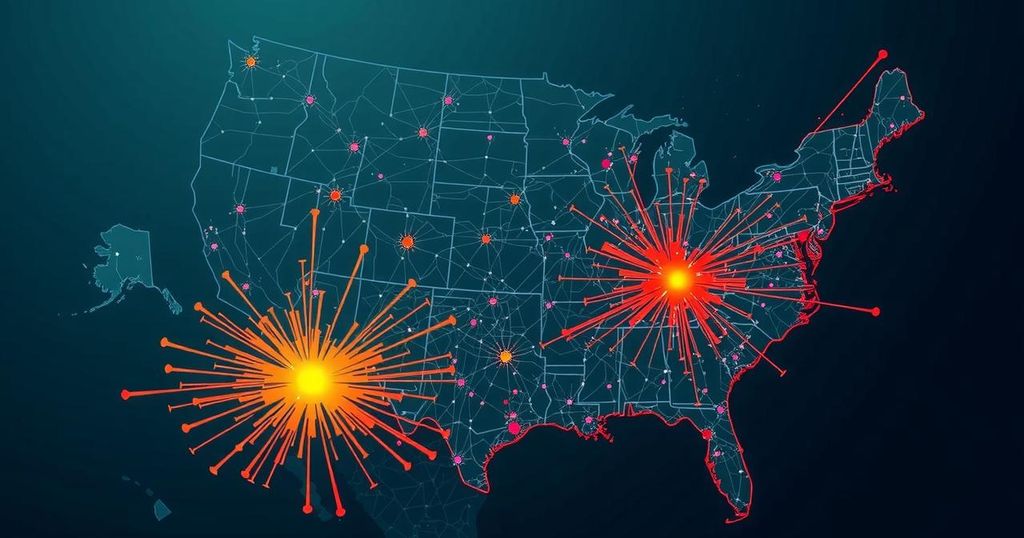On Thanksgiving Day, a series of minor earthquakes occurred across Virginia, Mississippi, Tennessee, and Arkansas, with a notable earthquake of magnitude 2.5 striking Mississippi. While there were no damages or injuries, experts caution that the New Madrid Seismic Zone remains at risk for larger earthquakes, emphasizing the need for preparedness in anticipation of future seismic events.
On Thanksgiving Day, the eastern United States experienced a series of minor earthquakes, as reported by the United States Geological Survey (USGS). The strongest seismic event registered a magnitude of 2.5 in Mississippi, while other tremors ranged from 1.8 to 2.1 in Virginia, Tennessee, and Arkansas. Despite some residents feeling minor shaking or hearing associated booms, there were fortunately no reports of damage or injuries.
The tremors began in Virginia shortly before midnight, with a magnitude 1.8 earthquake occurring near Louisa at 11:39 PM, only 0.3 km deep. Following this, Mississippi experienced its quake at 1:48 AM, with a depth of 5 km near Canton. Several tremors were also recorded in western Tennessee, occurring from 4:23 AM to 5:08 AM, all near Ridgely, within the New Madrid Seismic Zone, ranging from 5.9 km to 6.1 km deep. A 2.1 magnitude earthquake struck Strawberry, Arkansas, at 4:24 AM, from a depth of 8 km.
Authorities are urging increased preparedness for potentially larger quakes in this historically active seismic region. The New Madrid Seismic Zone is notorious for its significant seismic activity; experts consider the occurrence of a major earthquake in the future to be a matter of “when” rather than “if.” The area has a daunting history, notably including devastating earthquakes in 1811 and 1812 that were felt across vast portions of the eastern United States.
The anniversary of these massive quakes approaches on December 16, a time that serves as a poignant reminder of the region’s vulnerability. The largest of these historical earthquakes, which struck Arkansas, had a magnitude of approximately 8.1, impacting states as far away as New York City and Charleston, South Carolina. The aftermath of the quakes included an extraordinary number of additional seismic events, estimated between 6,000 to 10,000 aftershocks, demonstrating the region’s ongoing seismic instability.
In addition to the immediate physical effects, the 1811-1812 events gave rise to unusual natural phenomena such as “earthquake lights” and heightened water temperatures, attributed to the intense ground shaking and friction. As the region remains at risk of future seismic activity, experts and residents alike should heed the lessons of history and prioritize preparedness initiatives.
The New Madrid Seismic Zone, located along the Mississippi River, is known for its seismic activity and has a long history of significant earthquakes. The region was the epicenter of a series of powerful quakes in the early 19th century, notably from December 1811 to 1812, which are among the most powerful recorded in U.S. history. These events raised awareness of the seismic risks in the area, prompting scientific inquiry into earthquake preparedness and mitigation strategies as the population has grown over time. The recent series of minor earthquakes serves as a reminder of this risk, especially since larger, more destructive quakes are anticipated in the future. Despite the relatively inconsequential nature of the Thanksgiving Day events, seismologists emphasize the necessity of being prepared should a major quake occur again, as the potential for widespread damage and loss of life is significant, given today’s population density.
In summary, the Thanksgiving Day earthquakes that rattled parts of Virginia, Mississippi, Tennessee, and Arkansas serve as a critical reminder of the seismic risks posed by the New Madrid Seismic Zone. Although these tremors were minor and without damaging consequences, they highlight the importance of preparedness in an area historically prone to significant seismic events. With the potential for a major earthquake looming, it is imperative that residents remain vigilant and proactive in their readiness for future seismic activity.
Original Source: weatherboy.com






